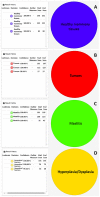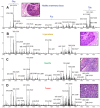Rapid Evaporative Ionization Mass Spectrometry-Based Lipidomics for Identification of Canine Mammary Pathology
- PMID: 36142485
- PMCID: PMC9502565
- DOI: 10.3390/ijms231810562
Rapid Evaporative Ionization Mass Spectrometry-Based Lipidomics for Identification of Canine Mammary Pathology
Abstract
The present work proposes the use of a fast analytical platform for the mass spectrometric (MS) profiling of canine mammary tissues in their native form for the building of a predictive statistical model. The latter could be used as a novel diagnostic tool for the real-time identification of different cellular alterations in order to improve tissue resection during veterinary surgery, as previously validated in human oncology. Specifically, Rapid Evaporative Ionization Mass Spectrometry (REIMS) coupled with surgical electrocautery (intelligent knife-iKnife) was used to collect MS data from histologically processed mammary samples, classified into healthy, hyperplastic/dysplastic, mastitis and tumors. Differences in the lipid composition enabled tissue discrimination with an accuracy greater than 90%. The recognition capability of REIMS was tested on unknown mammary samples, and all of them were correctly identified with a correctness score of 98-100%. Triglyceride identification was increased in healthy mammary tissues, while the abundance of phospholipids was observed in altered tissues, reflecting morpho-functional changes in cell membranes, and oxidized species were also tentatively identified as discriminant features. The obtained lipidomic profiles represented unique fingerprints of the samples, suggesting that the iKnife technique is capable of differentiating mammary tissues following chemical changes in cellular metabolism.
Keywords: CMT; REIMS; Rapid Evaporative Ionization Mass Spectrometry; canine mammary pathology; canine mammary tumors; iKnife; lipidomic; veterinary surgery.
Conflict of interest statement
The authors declare no conflict of interest.
Figures






Similar articles
-
Machine learning approach in canine mammary tumour classification using rapid evaporative ionization mass spectrometry.Anal Bioanal Chem. 2025 Jan;417(2):373-388. doi: 10.1007/s00216-024-05656-4. Epub 2024 Nov 19. Anal Bioanal Chem. 2025. PMID: 39562368
-
Rapid evaporative ionisation mass spectrometry of electrosurgical vapours for the identification of breast pathology: towards an intelligent knife for breast cancer surgery.Breast Cancer Res. 2017 May 23;19(1):59. doi: 10.1186/s13058-017-0845-2. Breast Cancer Res. 2017. PMID: 28535818 Free PMC article.
-
Real-Time In Situ Screening of Omega-7 Phospholipids in Marine Biological Resources Using an iKnife-Rapid-Evaporative-Ionization-Mass-Spectrometry-Based Lipidomics Phenotype.J Agric Food Chem. 2021 Aug 18;69(32):9004-9011. doi: 10.1021/acs.jafc.0c05442. Epub 2021 Jan 12. J Agric Food Chem. 2021. PMID: 33435687
-
Ambient Mass Spectrometry in Cancer Research.Adv Cancer Res. 2017;134:231-256. doi: 10.1016/bs.acr.2016.11.011. Epub 2016 Dec 29. Adv Cancer Res. 2017. PMID: 28110652 Review.
-
Surface analysis of lipids by mass spectrometry: more than just imaging.Prog Lipid Res. 2013 Oct;52(4):329-53. doi: 10.1016/j.plipres.2013.04.005. Epub 2013 Apr 24. Prog Lipid Res. 2013. PMID: 23623802 Review.
Cited by
-
From Lipid Signatures to Cellular Responses: Unraveling the Complexity of Melanoma and Furthering Its Diagnosis and Treatment.Medicina (Kaunas). 2024 Jul 25;60(8):1204. doi: 10.3390/medicina60081204. Medicina (Kaunas). 2024. PMID: 39202486 Free PMC article. Review.
-
Machine learning approach in canine mammary tumour classification using rapid evaporative ionization mass spectrometry.Anal Bioanal Chem. 2025 Jan;417(2):373-388. doi: 10.1007/s00216-024-05656-4. Epub 2024 Nov 19. Anal Bioanal Chem. 2025. PMID: 39562368
-
Applications of ambient ionization mass spectrometry in 2022: An annual review.Anal Sci Adv. 2023 Apr 26;4(5-6):133-153. doi: 10.1002/ansa.202300004. eCollection 2023 Jul. Anal Sci Adv. 2023. PMID: 38716065 Free PMC article. Review.
-
Identification strategy of wild and cultivated Astragali Radix based on REIMS combined with two-dimensional LC-MS.NPJ Sci Food. 2024 Nov 8;8(1):91. doi: 10.1038/s41538-024-00333-3. NPJ Sci Food. 2024. PMID: 39516475 Free PMC article.
References
-
- Sorenmo K.U., Worley D.R., Goldschmidt M.H. Tumors of the mammary gland. In: Vail D.M., Thamm D.H., Liptak J., editors. Withrow and MacEwen’s Small Animal Clinical Oncology. 5th ed. WB Saunders; Philadelphia, PA, USA: 2013. pp. 538–556.
-
- Merlo D.F., Rossi L., Pellegrino C., Ceppi M., Cardellino U., Capurro C., Ratto A., Sambucco P.L., Sestito V., Tanara G., et al. Cancer incidence in pet dogs: Findings of the animal tumor registry of Genoa, Italy. J. Vet. Intern. Med. 2008;22:976–984. doi: 10.1111/j.1939-1676.2008.0133.x. - DOI - PubMed
MeSH terms
Substances
LinkOut - more resources
Full Text Sources

